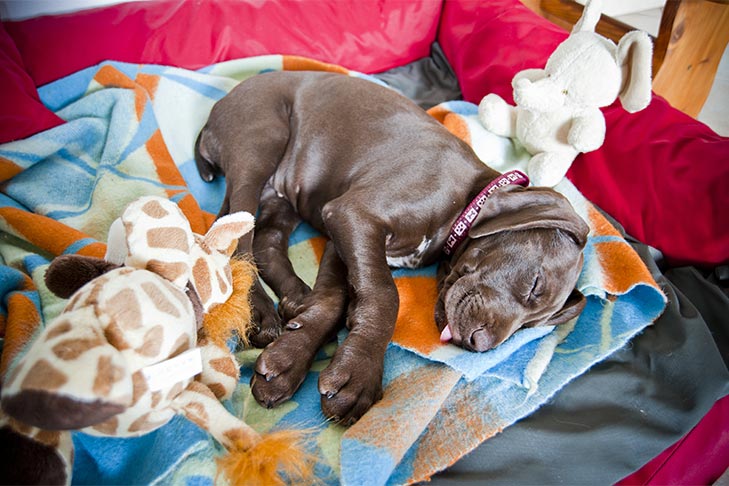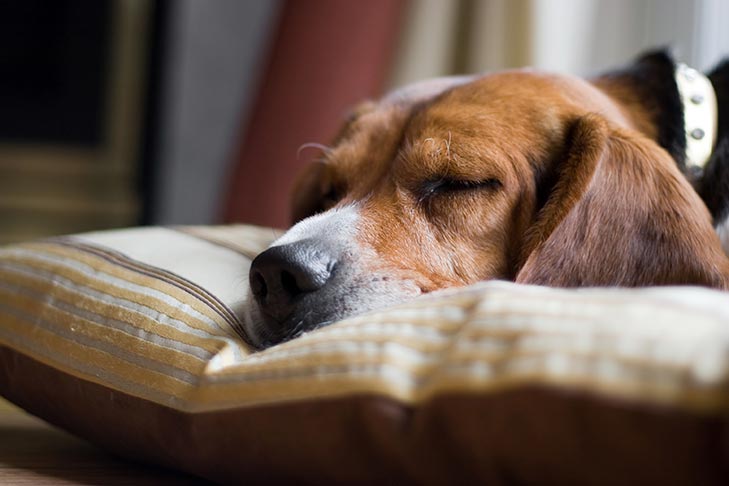- Keep puppies and new rescue dogs on a sleep schedule to establish good habits.
- Add flexibility to the schedule, until your dog develops problem behaviors.
- Consult your veterinarian if your dog develops sleep issues that affect their awake time or disrupt the household.

Given the option of getting up early or sleeping until late, my Chihuahua would rather stay under the covers. Mabel, who’s eight, can snooze for 12-plus hours overnight, without needing to take care of her business or wanting to eat breakfast. (Apparently, she’s more of a brunch girl.)
While this schedule is certainly convenient for owners who don’t have to get up and out early, is it healthy to let a dog sleep late every day?
According to Philadelphia-area trainer Nicole LaRocco-Skeehan, CPDT-KA, some dogs do just fine starting their day on their own terms. But if their behavior changes or they show signs of stress, such as peeing on the rug overnight, it could be a sign to set the alarm for them each morning.
“There are dogs who get themselves into trouble when they’re not being scheduled,” LaRocco-Skeehan says. “If they’re an adult dog, and they’re doing well, you can see what works for them. But if an adult dog starts having problems, the first thing you do is go back to the schedule.”
What Defines a Schedule?
Dogs tend to spend as much as half of their days asleep, 30 percent awake but relaxing, and just 20 percent being active. Older dogs require more sleep just because they tire out more easily and, as a general rule, bigger breeds also spend more time dozing.
The main consideration for a dog’s sleep schedule is when — and how frequently — they need to relieve themselves. “When we talk about whether to let dogs sleep late, 95 percent of the time, we’re talking about bathroom issues,” LaRocco-Skeehan says. “The dog is getting up in the middle of the night, going elsewhere and peeing, and coming back to bed.”
For a dog who develops overnight bathroom issues, you may also need to rethink their mealtimes. “It’s simple — calories in, calories out,” LaRocco-Skeehan says. “If you’re trying to figure out when it’s coming out, you need to know when it’s coming in.”
Dogs’ Sleep Patterns Are Different
Canine sleeping patterns closely mimic our own, but differ in a key way. Entering sleep, they take about 10 minutes to transition from the slow wave — during which breathing slows, blood pressure drops, and heart rate decreases — into rapid eye movement (REM). In the REM phase, their eyes roll under closed lids, and their body might react to dreams.
Dogs only spend about 10 percent of their snoozing time in REM because of their irregular sleep patterns. Since they tend to doze off whenever they want, often out of boredom, they also wake up quickly and jump to alertness. As a result, dogs require more total sleep to compensate for their lost REM.
By contrast, humans spend up to 25 percent of sleep in REM, reflecting their more typical schedule of staying awake all day and resting through the night.
But how much sleep a dog requires really depends on the individual pup. “You can’t put all dogs into one bucket — a lot depends on their age, their health, and just who they are,” LaRocco-Skeehan says. “Certain breeds have tendencies toward being more or less energetic, and so much depends on the individual dog.”

Factor in the Breed
The amount of sleep dogs need also depends on their breed. Working dogs, for example, must stay awake for such physical and mental tasks as protecting property, pulling sleds, and doing water rescues. Dogs who aren’t bred for a certain task (or have “retired” from their role) will lie around most of the day, with snoozing at the top of the agenda. That said, most dogs are resilient about adjusting their sleep schedules.
“If dogs go somewhere else, like a kennel, it may take a day or so to get them back into their schedule,” LaRocco-Skeehan says. “But most dogs can bounce back quickly. They’re good at knowing who they’re with and how to adapt to that situation.”
Put Your Puppy on a Sleep Schedule
Similar to babies, puppies will play and explore their new surroundings until they drop. Therefore, they might need up to 18–20 hours of sleep to recharge their batteries. Because they aren’t yet physically capable of going for long stretches overnight without relieving themselves, they will require a sleep schedule, according to LaRocco-Skeehan.
To figure out how much sleep your puppy needs before they have to take a potty break, apply this rule: Count one hour for every month-old and add one. For example, if you have a five-month-old puppy, they can sleep for six hours, before they need to go out. After nine or 10 months, many dogs can wait to relieve themselves for 10 to 12 hours. Recently rescued dogs may also need more structure with their overnight sleeping schedules.
“Once you set a good foundation, if your dog is settling in well, you can loosen up the schedule,” LaRocco-Skeehan says.
Look for Health Changes
Sleeping is the main event in most dogs’ daily lives, so you shouldn’t worry if your pup is a champion snoozer like Mabel. But if you develop a good schedule and something changes with your dog’s sleeping habits, the first step is to check with your veterinarian. Excessive sleep can signal conditions such as canine depression, diabetes, hypothyroidism, and possible loss of hearing.
“The first thing is to determine if the problem is behavioral or medical,” LaRocco-Skeehan says. “If you’re just dealing with a dog that needs to go out more frequently, you can set a new schedule and help them know when they are going out.”

